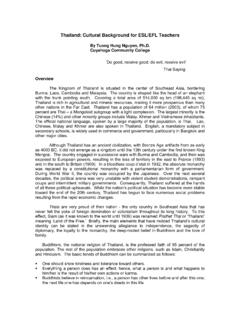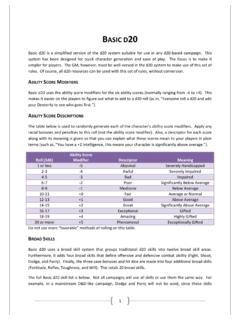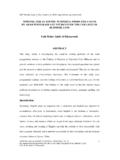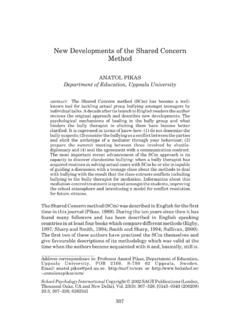Transcription of Diplomatic protocol manual final - Euro Atlantic Diplomacy ...
1 Diplomatic protocol manual 1. Table of Contents. 1) Diplomatic protocol : definitions, aims and application 2) Important elements of Diplomatic protocol : a) Ceremony b) Etiquette c) Titles d) Correspondence e) Savoir-vivre f) Wardrobe g) Dinning 3) Literature 2. 1. Diplomatic protocol : definitions, aims and application Each Ministry of Foreign Affairs writes its own Diplomatic protocol . When different protocols are compared, certain differences may be noticeable, such as cross-cultural ones. With the main aim being proper Tip: See your country's Diplomatic protocol and respectful communication between diplomats, written by your Ministry of Foreign Affairs. It differences between cultures can be seen as a positive will help you to get into a role of a diplomat.
2 Rather than negative. What is the Diplomatic protocol ? The Macquarie Dictionary defines it as the customs and regulations dealing with the ceremonies and etiquette of the Diplomatic corps.. The protocol Queensland states: the principal role of diplomats and the Diplomatic corps is to foster mutually beneficial relations between nation states. [A Diplomatic ]. protocol is therefore about building relationships and facilitating positive outcomes for the parties involved.. For practical purposes, a Diplomatic protocol is about following correct procedures. It is the art of ensuring that official (and unofficial) occasions, visits, meetings and functions are planned and conducted in accordance with a set Courtesy, Respect and Professionalism of rules that are formally, socially and culturally accepted are most important components of a Diplomatic protocol - and expected by the parties involved.
3 Tomasz Or owski The Diplomatic protocol is used as a tool for the mutual communication in order to minimize the possibility of Diplomatic blunders as much as possible. It is not only used in Diplomacy but also in other professional areas, such in the world of large multinational companies. After all, the m o s t i m p o r t a n t c o m p o n e n t s s u c h a s C o u r t e s y, Professionalism and Respect are important concepts in different spheres of our lives. 3. 2. Important Elements of the Diplomatic protocol . A) Ceremony. A ceremony (fr. c r monie) is the official public act with an official character that progresses with the previously established rules and procedures. With each ceremony there is a master of ceremony who makes sure that the ceremony ends in the way it is expected.
4 There are various forms of ceremonies such as public state ceremonies, state funerals, the singing of the national anthem, opening up a public building or unveiling a plaque, presentation of awards and ceremonies, and many others. During ceremonies the representatives may need to provide a speech. There are only a few rules during the presentation of a speech during a ceremony. At the beginning it is a host who gives a voice. His or her speech is typically very short and its aim is to welcome the guests and provide the aim of the event. Next in order is the office held by the honorary guests. In some countries, such as Poland, the first honorary guest speech is delivered by a person who holds the highest office.
5 In other countries, such as France, the most important guest speaks at the very end. Only one person speaks for one institution. The common approximate number of honorary guests is two to three. B) Etiquette. An etiquette or savoir-vivre is a set of rules that are accepted by everyone in order to smooth functioning of the society. Each delegate is expected to act based on basic rules of etiquette. When following etiquette one should basically express the values one believes in as a member of a greater collective. Among these values are politeness and respectfulness. There are few elements of etiquette that are worth mentioning in this Diplomatic protocol : 1. Treat other people the way you would like to be treated 2.
6 Respect other people's privacy and do not comment or impose on others your tastes and liking 3. Respect people based on seniority ( women, meritorious individuals, public officials, superiors and representatives of institutions). 4. Be tolerant and discrete to other individual 5. Be punctual. C) Titles. The usage of right title is one of the most important codes in the Diplomatic protocol . We acknowledge a person with a particular title depending on the function he or she is presenting (royalty and vice- regal, government and parliament, 4. judiciary, local government, Diplomatic and consular corps, military and religious) and depending on the occasion. For instance, if one were to talk to an Ambassador of their own country, one would address him as Ambassador.
7 ' When writing an invitation one would write His/Her Excellency [Initial] [Surname]'. The title his/her Excellency' will be also used to refer to the High Commissioner. For more details on different titles please see protocol Queensland on page 45 (Attachment 1). D) Correspondence. The correspondence used during the Model NATO Youth Summit between the delegates should be formal. We encourage the formal language and style. For example, when writing a message to other delegates you may want to start your message with Dear Sir, Dear Madam' or by referring to his or her title. When ending the message, end with the following phrases: Your faithfully' or Respectfully.' Do not forget to end the letter with your full name and the title and a country you are representing.
8 Write your message in a clear manner. If for instance you want to invite another delegate to a meeting outside schedule or during a break, write at what time and where you want to meet him or her. E) Savoir-vivre. There are few elements of savoir vivre, which are worth mentioning: 1. Greetings: it is both a form of salute and a show of respect. In European culture the greeting form includes words such as Good morning or Good evening, a bow or a handshake (determined but not bone crashing. In a more information environment, a kiss on both cheeks is often used. The form used during a greeting should be used again during a farewell. 2. The order of greeting: to put it simply: the younger greets the older, men greet women and an employee greets an employer.
9 However, there are exceptions, such as when a woman greets a an older man first. In farewell the order is vice versa. Remember: if you are entering a room full of people waiting for you, you greet them first no matter of the gender or your employment status. 3. The order of entering a room/lift: similar like with a greeting, we first allow to enter a woman, employers and seniors. When entering a room yourself, look behind you to see if there is someone following- it is polite and proper to keep a door open for the person behind you. 4. The order of leaving room/life: same as above. If there is a group waiting outside, we first allow people to leave a room and then a new group may enter the place.
10 5. 5. Hand grip: remember that representatives in some cultures may feel uncomfortable when greeting with a handshake. In Muslim culture a man cannot handshake with a woman. The handshake is not often used in Japan and Britain (with some difference to business groups). Please note that we are also moving away from a custom of kissing a women's hand. If she does not want to, just follow her wish. 6. Introduction and conversation: we use the same rule of order when we introduce two people. We introduce a man to a woman, the younger to senior and the employee to employer. If you are unsure about the name of your quests, simply allow them to introduce him/herself. 7. Gift is always a symbol of sympathy and respect.





